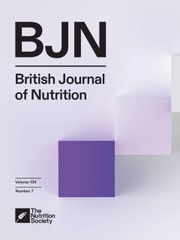Dear Editor,
We appreciate the opportunity to respond to the Letter to the Editor by Kumar et al.(Reference Kumar, Mehta and Sah1) regarding our recently published article, ‘Diet’s total antioxidant capacity and women’s health: systematic review and meta-analysis’, in the British Journal of Nutrition (Reference Dutra, Fragoso and Wanderley2). We thank the authors of the Letter for their kind and thoughtful comments and for recognising its potential contribution to the field of women’s health and nutrition. The observations presented are meaningful and insightful, and we are glad to provide our responses below:
Sensitivity analysis based on specific methodological domains
We appreciate the suggestion to consider a sensitivity analysis based on studies presenting methodological concerns in specific domains of the Joanna Briggs Institute (JBI) appraisal tool. However, in our review, all studies included in the meta-analysis met the criteria of the tool and were considered methodologically adequate overall. Only one study, which focused on abortion and used the Dietary Antioxidant Index method, did not meet JBI quality criteria and was therefore rated as low quality. As it was not included in the meta-analysis and addressed a distinct outcome, it does not affect the results related to other conditions or antioxidant assessment methods. Even after excluding this study, eleven of the nineteen studies demonstrated significant associations between dietary total antioxidant capacity and the outcomes of interest.
Given this context, we did not identify any included studies with isolated high-risk assessments that would justify a domain-specific sensitivity analysis. Nevertheless, we value this observation and consider it a relevant approach for future reviews as the body of evidence on this topic expands.
Choice of quality assessment tool
We truly appreciate the suggestion to use the Grading of Recommendations, Assessment, Development and Evaluation framework for assessing the certainty of evidence. However, we acknowledge that its application in systematic reviews of observational studies, which often receive ‘moderate’ certainty ratings, is a matter of ongoing debate in the literature(Reference Tobias, Wittenbecher and Hu3). While adaptations like Grading of Recommendations, Assessment, Development and Evaluation-Nut have been proposed for nutrition research, we chose not to apply them in this review, as our methodology was not designed with this framework in mind. We agree that randomised trials are essential for confirming associations, and we believe the current body of evidence should be interpreted with this in mind.
Representativeness and population diversity
We agree with the importance of considering the characteristics of the populations involved in the studies. In our discussion section, we addressed the geographical distribution of the included studies and the potential cultural and environmental influences on dietary total antioxidant capacity and women’s health outcomes. Specifically, we noted that most studies were conducted in Iran, with others from Italy, the USA, Korea, the Netherlands and Turkey and discussed how this diversity may affect generalisability. We also highlighted the need for future research in other populations to strengthen external validity.
Variability in dietary total antioxidant capacity assessment methods
We fully recognise the heterogeneity in methods used to estimate dietary total antioxidant capacity, such as Oxygen Radical Absorbance Capacity, Dietary Antioxidant Index, Ferric Reducing Ability of Plasma, Total Radical-Trapping Antioxidant Parameter, Vitamin C Equivalent and Trolox Equivalent Antioxidant Capacity. This was thoroughly addressed in our manuscript, especially in the limitations and future directions. We emphasised the necessity of methodological standardisation in future studies and acknowledged how this variability may affect comparability and interpretation of results.
Conclusion and future directions
As the first systematic review and meta-analysis to synthesise this topic, our goal was to offer a comprehensive foundation for future research and dietary guidelines. We are encouraged by the interest and engagement of fellow researchers and remain committed to advancing this important area of nutritional science.
We are grateful for the detailed and thoughtful suggestions, which have highlighted several areas for improvement and future focus. Your comments underscore the importance of methodological rigour, standardisation and transparency in research. These enhancements will not only improve the validity and applicability of future reviews but also provide a stronger foundation for clinical and policy-level recommendations.
Once again, we thank you for your valuable feedback and your recognition of our work as a significant contribution to understanding the health implications of dietary total antioxidant capacity in women. We look forward to seeing how future research builds upon this foundation to explore the full potential of diet in promoting women’s health and well-being.
Sincerely,
Tauane Dutra, Nassib Bueno, Alane de Oliveira.
Authors of ‘Diet’s total antioxidant capacity and women’s health: systematic review and meta-analysis’.
Acknowledgements
None.
No funding was received.
T. A. D. developed the main ideas, wrote the original draft, and carefully reviewed and addressed the comment on the manuscript. N. B. B. contributed to refining the arguments, revised the manuscript, and provided supervision. A. C. M. O. also contributed to the revision process and offered supervision. All authors participated in refining the manuscript to enhance its clarity and accuracy.
The authors declare no conflict of interest.


